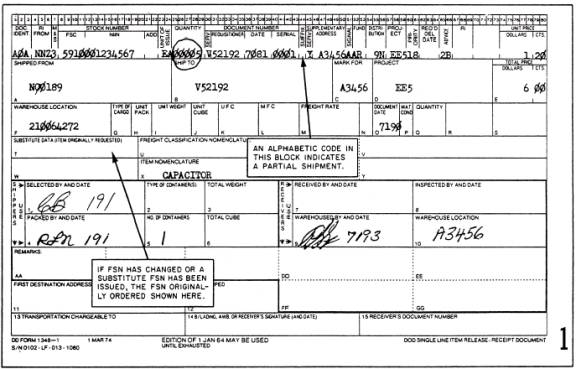|
PREPARING A MILSTRIP REQUISITION
LEARNING OBJECTIVE : Recognize MILSTRIP requisition procedures and how
they are used for material receipt, custody,
and stowage.
MILSTRIP uses coded data for processing
requisitions with automatic data processing
equipment. No matter what type of requisitioning
document you use, use extreme care in
selecting and entering the coded data
elements. These codes apply to all
levels of supply. Although they are too numerous
for all to be included in this chapter, the codes can be
found in the appendices of NAVSUP P-485.
The following general rules apply to
MILSTRIP requisition:
Enter data by ball-point pen or typewriter. Do not use pencil; pencil
marks can cause errors when the
requisition is processed through mark
sensing equipment.
Data should be entered between the "tic" marks on the form. However, it is
mandatory that entries be included
within the data fields to which they
pertain.
To eliminate confusion between the numeral zero and the letter "O," use
the communications zero (f) on MILSTRIP
requisitions when zeros are applicable.
Specific details for completing DDForm 1348 and
NAVSUP Form 1250-1 can be found in NAVSUP
P-485.
MATERIAL RECEIPT, CUSTODY, AND STOWAGE
For every procurement action taken, there is a
receipt action that follows. Once the supplies are
received, they must be identified, checked,
and distributed to the appropriate
storeroom or department, and
documentation as to their receipt, custody and
stowage must be accomplished.
Material Receipt
As in every situation, responsibility for actions
taken must be assigned to key personnel. In the receipt
of government-owned materials,
responsibility for receipts takes on an
added importance because of the many
types of material receipts and the required
accountability.
Receipt Documentation
There are several types of receipt papers, and
which type is used depends upon the manner in which
the material was requested, the issuing
activity, and the modes of
transportation used in delivery. The most
commonly encountered receipt is the DoD Single Line
Item Release/Receipt Document, DD Form
1348-1, (fig. 13-6). Regardless of the
type of receipt document, the end-use
receiver must
1. date the document upon receipt,
2. circle the quantity accepted, and
3. sign the document to indicate receipt.
Receiving Procedures
Small quantities of stores received on a daily basis
require no special preparations for receipt.
Stock large quantities of stores in a
central area out of the traffic flow
and hold there until preliminary identification
and package count are completed. Then sort them
according to the department or storeroom to
which they will be distributed.
Report of Discrepancy
Item or packaging discrepancies attributable to the
shipper (including contractors,
manufacturers, or vendors) should be
reported on the Report of Discrepancy
(ROD), SF 364, by the receiving activity.
The purpose of the ROD is to determine the cause of
the discrepancy, effect corrective action,
and prevent recurrence. When both item
discrepancies and packaging
discrepancies are noted on the same
shipment, both blocks on the top of SF 364 should be
checked and the types of discrepancies
noted. The types of discrepancies
required to be reported are described
in chapter 4 of NAVSUP P-485. Detailed
instructions for preparing and distributing of RODsare
contained in the current version of
SECNAVINST 4355.18.
Custody
The term custody refers to the responsibility for
proper care, stowage, and use of Navy
material and records pertaining to
such. Stored material is required to be
kept under lock and key, except when the material
is too numerous or too large to make such stowage
impractical. Lock storeroom spaces securely
when not in use.
Stowage
Material in storerooms and other designated
stowage areas should be arranged to
ensure maximum use of available space,
provide orderly stowage and ready accessibility,
prevent damage to spaces or injury to personnel,
reduce the possibility of material loss or damage,
make it easy to issue the oldest stock first, and
make it easy to inventory.
The preceding criteria and a "common-sense"
approach will enable storeroom personnel to achieve
stowage efficiency. To the maximum extent
that available space permits, you
should adhere to the following
guidelines when stowing material:
Locate heavy bulk material and materials handling equipment near hatches
or doors to minimize the physical effort
required for loading, stowage, and
breakout.

Figure 13-6.-DoD Single Item Release/Receipt Document, DD Form 1348-1.
Locate light bulky materials in storerooms with high overhead clearances for
maximum use of available space.
Segregate materials that are dissimilar in type or classification.
Locate frequently requested materials as close as possible to the point of
issue.
Locate shelf-life items in a readily accessible area to facilitate periodic
screening.
Install appropriate stowage aids (flashlight, paper, and pencil) in spaces
where they are readily accessible.
Make aisles at least 30 inches wide, if possible.
Arrange material with identification labels facing outward to make issue and
inventory easy.
Avoid multiple locations for the same item.
If you follow the preceding criteria and guidelines,
you should have no problems in maintaining your
spaces and issuing and inventorying
materials.
|







